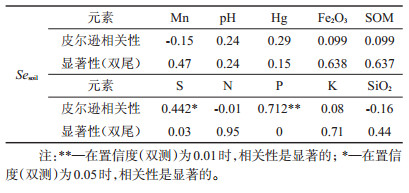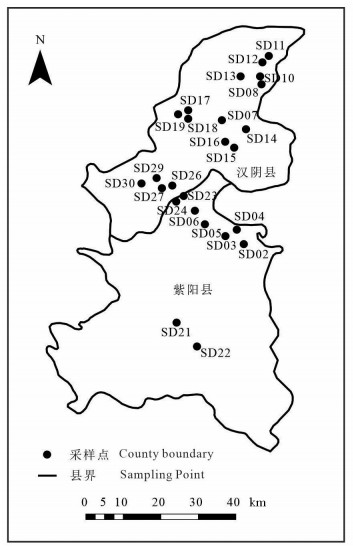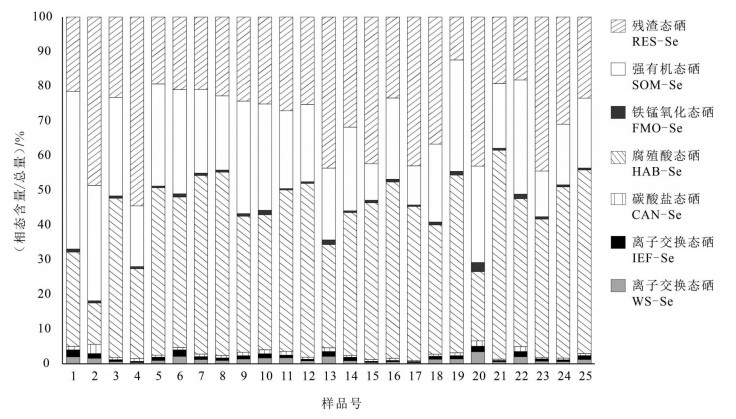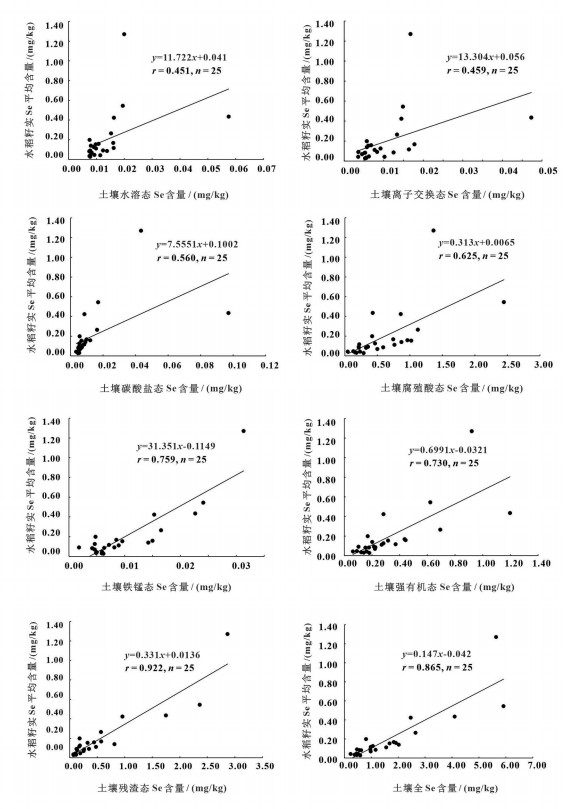A study of the Selenium speciation in paddy soil and status of selenium-enriched rice in western part of Ankang City, Shaanxi Province
-
摘要:
研究目的 对土壤中硒元素的有效吸收是水稻富硒的关键,而土壤中硒的形态则是影响水稻吸收能力的直接影响因素之一,为了探讨影响富硒土壤中硒的形态与水稻籽实中硒含量的关系,本文对陕西省安康市西部土壤开展了定量研究。
研究方法 本文对研究区土壤硒的形态以及水稻富硒状况进行测定,获得了土壤中各形态硒的赋存状态分布特征。
研究结果 安康市西部富硒土壤中各形态硒的含量差异较大,其中腐殖酸态、强有机态和残渣态的硒含量较高,占总硒的90%以上;而水溶态、离子交换态、铁锰态、碳酸盐态的硒含量较低,占总硒比例低于5%;当地土壤中水溶态、离子交换态硒与水稻对硒的吸收有着密切相关性,这与其他学者近期的研究结果类似,为富硒水稻的开发提供理论基础;研究区水稻籽实中硒的平均含量为0.20 mg/kg,达到国家富硒水稻的标准。
结论 研究区土壤富硒状况良好,水稻籽实中硒的含量符合国家富硒标准,富硒水稻的开发具有广阔前景。
Abstract:This paper is the result of agricultural geological survey engineering.
Objective The uptake and accumulation of selenium in rice grain is determined by the bioavailability of selenium in paddy soils, which can be directly affected by its speciation pattern.In this study, the selenium speciation in soils from the west of Ankang City, Shaanxi province was analyzed to investigate the correlation of selenium content in rice grain with the speciation pattern of selenium in soils.
Methods The distribution characteristics of seleniumspeciation in soils was examined by analyzing the concentrations of selenium in soils and rice grain.
Results The concentrations of speciation fractions varied significantly. Detailedly, the humic acid boundfraction of selenium accounted for more than 90% of the total content, whereas the water-solublefraction, ion-exchangeable fraction, manganese oxides fraction and carbonate bounded fraction occupied less than 5%. This study observed a tight relationship between the rice uptake of selenium and its concentration ofwater-soluble fraction andion-exchangeable fraction in paddy soils, which was consistent with the results found in previous studiesand will provide fundamental basis for the development of selenium-rich rice. The average concentration of selenium in rice grainwas 0.20 mg/kg, which met the national standard.
Conclusions The enrichment degree of selenium in paddy soils from the study area was high. This caused the relative accumulation of selenium in rice grain, which met the national standard. This study reveals broad prospects in the development of selenium-rich rice.
-

-
表 1 元素分析方法与检出限
Table 1. Element analysis methods and detection limit

表 2 研究区水稻根系土壤基本理化性质和养分元素含量统计表(n=25)
Table 2. Physical and chemical properties and soil nutrient abundances in paddysoil samples (n=25)

表 3 水稻根系土样品硒含量与养分元素含量相关性系数(n=25)
Table 3. Pearson's correlation coefficient of selenium and nutrient elements content in paddy soils (n=25)

表 4 水稻根系土样品的全量硒和各形态的硒的相关性系数(n=25)
Table 4. Pearson's correlation coefficient of total selenium and various forms of selenium in paddy soils (n=25)

-
Banuelos G S, Arroyo I, Pickering I J, Yang S I, Freeman J L. 2015. Selenium biofortification of broccoli and carrots grown in soil amended with Se-enriched hyperaccumulator Stanleya pinnata[J]. Food Chemistry, 166(1): 603-608.
Chang C, Yin R, Wang X, Shao S, Chen C, Zhang H. 2019. Selenium translocation in the soil-rice system in the Enshi seleniferous area, Central China[J]. Science of the Total Environment, 669(15): 83-90.
Chen Xianjian, Li Haohao. 2016. Study on the distribution of soil selenium content in Guangzhou and its influencing factors [J]. Fujian Journal of Agricultural Sciences, 31(4): 401-407 (in Chinese with English abstract).
China Geological Survey. 2005. Technical Requirements for Sample Analysis for Ecological Geochemical Evaluation (DD2005-03) [S]. Beijing: China Standard Press, 5-11 (in Chinese).
Dinh Quang Toan, Cui Zewei, Huang Jie, Thi Anh Thu, Wang Dan, Yang Wenxiao, Zhou Fei, Wang Mengke, Yu Dasong, Liang Dongli. 2018. Selenium distribution in the Chinese environment and its relationship with human health: A review[J]. Environment International, 112(3): 294-309.
Guo Yu, Bao Zhengyu, Ma Zhenzhen, Li Hui, Wei Changhua, Yan Sen. 2012. Geochemical characteristics of Se in soil-plant system in Enshi area, Hubei[J]. Geological Bulletin of China, 31(1): 151-155 (in Chinese with English abstract).
Huang Taiqing, Jiang Zepu, Xing Ying, Liao Qing, Liang Panxia, Liu Yongxian. 2017. Study on the absorption and utilization of exogenous selenium in rice[J]. Journal of Agricultural Resources and Environment, 34(5): 449-455 (in Chinese with English abstract).
Jia M, Zhang Y, Huang B, Zhang H. 2019. Source apportionment of selenium and influence factors on its bioavailability in intensively managed greenhouse soil: A case study in the east bank of the Dianchi Lake, China[J]. Ecotoxicology and Environmental Safety, 170(4): 238-245.
Jones G D, Droz B, Greve P, Gottschalk P, Poffet D, Mcgrath S P, Seneviratne S I, Smith P, Winkel L. 2017. Selenium deficiency risk predicted to increase under future climate change[J]. Proceedings of the National Academy of Sciences of the United States of America, 114(11): 2848-2853. doi: 10.1073/pnas.1611576114
Kikkert J, Berkelaar E. 2013. Plant uptake and translocation of inorganic and organic forms of selenium[J]. Archives of Environmental Contamination & Toxicology, 65(3): 458-465.
Li Z, Zeng H, Cheng W H. 2018. Beneficial and paradoxical roles of selenium at nutritional levels of intake in healthspan and longevity[J]. Free Radical Biology and Medicine, 127: 3-13. doi: 10.1016/j.freeradbiomed.2018.05.067
Liao Qilin, Ren Jinghua, Xu Weiwei, Cui Xiaodan, Jin Yang, Li Wenbo, Fan Jian, Zhu Bowan. 2016. Geological and geochemical background of selenium-enriched rice producing area in Yili, Jiangsu. [J]. Geology in China, 43(5): 1791-1802 (in Chinese with English abstract).
Luo Kunli, Jiang Jisheng. 1995. Selenium content and its enrichment law in the Lower Cambrian strata of Ziyang and Langao, Shaanxi[J]. Earth and Environment (1): 68-71 (in Chinese).
Maiz I, Arambarri I, Garcia R, Millán E. 2000. Evaluation of heavy metal availability in polluted soils by two sequential extraction procedures using factor analysis[J]. Environmental Pollution, 110(1): 3- 9. doi: 10.1016/S0269-7491(99)00287-0
Mao J, Pop V J, Bath S C, Vader H L, Redman C, Rayman M P. 2014. Effect of low-dose selenium on thyroid autoimmunity and thyroid function in UK pregnant women with mild-to-moderate iodine deficiency[J]. European Journal of Nutrition, 55(1): 55-61.
Ministry of Land and Resources of the People's Republic of China. 2016. Standard for Geochemical Evaluation of Land Quality (DZ/T 0295-2016) [S]. Beijing: Geological Publishing House, 6-13 (in Chinese).
Moreda-Piñeiro J, Moreda-Piñeiro A, Bermejo-Barrera P. 2017. In vivo and in vitro testing for selenium and selenium compounds bioavailability assessment in foodstuff[J]. C R C Critical Reviews in Food Technology, 57(4): 805-833. doi: 10.1080/10408398.2014.934437
Noll M R. 2002. Trace Elements in Terrestrial Environments[J]. Journal of Environment Quality, 32(1): 372-374.
Peng Q, Li J, Wang D, Wei T J, Chen C E L, Liang D L. 2019. Effects of ageing on bioavailability of selenium in soils assessed by diffusive gradients in thin-films and sequential extraction[J]. Plant and Soil, 436(1): 159-171.
Pueyo M, López-Sánchez J F, Rauret G. 2004. Assessment of CaCl2, NaNO3 and NH4NO3 extraction procedures for the study of Cd, Cu, Pb and Zn extractability in contaminated soils[J]. Analytica Chimica Acta, 504(2): 217-226. doi: 10.1016/j.aca.2003.10.047
Qin Haibo, Zhu Jianming, Lin Zhiqing, Xu Wenpo, Tan Decan, Zheng Lirong, Takahashi Yoshio. 2017. Selenium speciation in seleniferous agricultural soils under different cropping systems using sequential extraction and X-ray absorption spectroscopy[J]. Environmental Pollution, 225: 361-369. doi: 10.1016/j.envpol.2017.02.062
Rohn I, Marschall T A, Kroepfl N, Jensen K B, Aschner M, Tuck S, Kuehnelt D, Schwerdtle T, Bornhorst J. 2018. Selenium species-dependent toxicity, bioavailability and metabolic transformations in Caenorhabditis elegans[J]. Metallomics, 10(6): 818-827. doi: 10.1039/C8MT00066B
Saeedeh P, Hossein M, Soheyla H, Iraj K. 2018. Biological synthesis of selenium nanoparticles and evaluation of their bioavailability[J]. Brazilian Archives of Biology and Technology, 60-62.
Shao Y, Cai C, Zhang H, Wei F, Shen T. 2018. Controlling factors of soil selenium distribution in a watershed in Se-enriched and longevity region of South China[J]. Environmental Science and Pollution Research, 25(20): 20048-20056. doi: 10.1007/s11356-018-2091-2
Shi Z, Pan P, Feng Y, Kan Z, Li Z, Wei F. 2017. Environmental water chemistry and possible correlation with Kaschin-Beck Disease (KBD) in northwestern Sichuan, China[J]. Environment International, 99: 282-292. doi: 10.1016/j.envint.2016.12.006
Sun Chao, Hou Qingye, Yang Zhongfang, Yang Xiaoyan, Huang Yong, Chen Enke. 2010. Study on the factors affecting the migration and transformation of selenium in typical soil environments: A case study of Chengdu Economic Zone in Sichuan Province [J]. Geology in China, 37(6): 1760-1768 (in Chinese with English abstract).
Supriatin S, Weng L, Comans R. 2015. Selenium speciation and extractability in Dutch agricultural soils[J]. Science of the Total Environment, 532(1): 368-382.
Tang Yuxia, Wang Huimin, Liu Qiaoling, Lü Yinghua, Meng Chunxiang. 2010. Study on the content, form and availability of selenium in wheat field soil in Hebei Province. [J] Acta Agriculturae Boreali-Sinica, 25(00z): 194-197(in Chinese with English abstract).
Wang S, Liang D, Wang D, Wei W, Fu D, Lin Z. 2012. Selenium fractionation and speciation in agriculture soils and accumulation in corn (Zea mays L. ) under field conditions in Shaanxi Province, China[J]. Science of the Total Environment, 427: 159-164.
Wang Xiao, Zhang Zhen, Zhu Jiang, Song He, Dong Zhaorong. 2019. Study on the correlation between selenium forms in selenium-enriched soil and rice-enriched selenium in Qingyang County [J]. Earth and Environment, 47(3): 9-13 (in Chinese with English abstract).
Wen Bangyong, Zhang Taoliang, Li Xizhou, Xie Zhendong. 2014. Feasibility study on development of selenium-rich soil resources in Longnan area, Jiangxi[J]. Geology in China, 41(1): 256-263(in Chinese with English abstract).
Wu Jun. 2018. Soil Se distribution characteristics and influencing factors in Shouning County, Fujian Province [J]. Geology in China, 45(6): 1167-1176(in Chinese with English abstract).
Xiao K, Tang J, Chen H, Li D, Liu Y. 2020. Impact of land use/land cover change on the topsoil selenium concentration and its potential bioavailability in a karst area of southwest China[J]. Science of The Total Environment, 708: 135-201.
Xu Yongxin. 2012. Occurrence State and Chemical Activity of Selenium in Selenium-rich Rock Formations in Ziyang, Shaanxi and Enshi, Hubei[D]. University of Chinese Academy of Sciences, 19-23 (in Chinese with English abstract).
Yang Kui, Li Xiangling, Zhang Jingya, Zhang Lingxi, Shang Shigui, Zhang Qianming, Wang Yanming. 2018. Selenium bioavailability and its influencing factors in potentially Se-enriched soils in Lujiang, Anhui[J]. Research of Environmental Sciences, 31(4): 715 -724 (in Chinese with English abstract).
Yoshida S, I Wa Taka M, Fuchigami T, Haratake M, Nakayama M. 2018. In vitro assessment of bioavailability of selenium in Niboshi processed from Japanese anchovy[J]. Food Chemistry, 269: 436-441. doi: 10.1016/j.foodchem.2018.07.033
Yu Tao, Yang Zhongfang, Wang Rui, Zeng Qingliang, Hou Wanling. 2018. Characteristic and source analysis of soil selenium and other elements in typical selenium-enriched areas in Enshi [J]. Soils, 50(6): 63-69 (in Chinese with English abstract).
陈显著, 李就好. 2016. 广州市土壤硒含量的分布及其影响因素研究[J]. 福建农业学报, 31(4): 401-407. https://www.cnki.com.cn/Article/CJFDTOTAL-FJNX201604013.htm
郭宇, 鲍征宇, 马真真, 李慧, 魏昌华, 严森. 2012. 湖北恩施地区土壤-植物系统中Se元素的地球化学特征[J]. 地质通报, 31(1): 151-155. doi: 10.3969/j.issn.1671-2552.2012.01.019
黄太庆, 江泽普, 邢颖, 廖青, 梁潘霞, 刘永贤. 2017. 水稻对外源硒的吸收利用研究. 农业资源与环境学报, 34(5): 449-455. https://www.cnki.com.cn/Article/CJFDTOTAL-NHFZ201705007.htm
廖启林, 任静华, 许伟伟, 崔晓丹, 金洋, 李文博, 范健, 朱伯万. 2016. 江苏宜溧富硒稻米产区地质地球化学背景. [J] 中国地质, 43(5): 1791-1802. http://geochina.cgs.gov.cn/geochina/ch/reader/view_abstract.aspx?file_no=20160527&flag=1
雒昆利, 姜继圣. 1995. 陕西紫阳, 岚皋下寒武统地层的硒含量及其富集规律[J]. 地质地球化学, (1): 68-71. https://www.cnki.com.cn/Article/CJFDTOTAL-DZDQ199501015.htm
孙朝, 侯青叶, 杨忠芳, 杨晓燕, 黄勇, 陈恩科. 2010. 典型土壤环境中硒的迁移转化影响因素研究——以四川省成都经济区为例[J]. 中国地质, 37(6): 1760-1768. doi: 10.3969/j.issn.1000-3657.2010.06.023 http://geochina.cgs.gov.cn/geochina/ch/reader/view_abstract.aspx?file_no=20100623&flag=1
唐玉霞, 王慧敏, 刘巧玲, 吕英华, 孟春香. 2010. 河北省麦田土壤硒的含量、形态及其有效性研究. [J] 华北农学报, 25(00z): 194-197. https://www.cnki.com.cn/Article/CJFDTOTAL-HBNB2010S1045.htm
王潇, 张震, 朱江, 宋贺, 董召荣. 2019. 青阳县富硒土壤中硒的形态与水稻富硒的相关性研究[J]. 地球与环境, 47(3): 9-13. https://www.cnki.com.cn/Article/CJFDTOTAL-DZDQ201903013.htm
文帮勇, 张涛亮, 李西周, 谢振东. 2014. 江西龙南地区富硒土壤资源开发可行性研究[J]. 中国地质, 41(1): 256-263. doi: 10.3969/j.issn.1000-3657.2014.01.021 http://geochina.cgs.gov.cn/geochina/ch/reader/view_abstract.aspx?file_no=20140121&flag=1
吴俊. 2018. 福建省寿宁县土壤硒分布特征及影响因素[J]. 中国地质, 45(6) : 1167-1176. http://geochina.cgs.gov.cn/geochina/ch/reader/view_abstract.aspx?file_no=20180607&flag=1
徐永新. 2012. 陕西紫阳和湖北恩施富硒岩层中硒的赋存状态及化学活动性研究[D]. 中国科学院研究生院, 19-23.
杨奎, 李湘凌, 张敬雅, 章凌曦, 尚世贵, 张千明, 王延明. 2018. 安徽庐江潜在富硒土壤硒生物有效性及其影响因素[J]. 环境科学研究, 31(4): 715-724. https://www.cnki.com.cn/Article/CJFDTOTAL-HJKX201804015.htm
余涛, 杨忠芳, 王锐, 曾庆良, 侯宛苓. 2018. 恩施典型富硒区土壤硒与其他元素组合特征及来源分析[J]. 土壤, 50(6): 63-69. doi: 10.3969/j.issn.1673-3908.2018.06.013
中国地质调查局. 2005. 生态地球化学评价样品分析技术要求(DD2005-03)[S]. 北京: 中国标准出版社, 5-11.
中华人民共和国国土资源部. 2016. 土地质量地球化学评价规范(DZ/T 0295-2016)[S]. 北京: 中国地质出版社, 6-13.
-




 下载:
下载:





